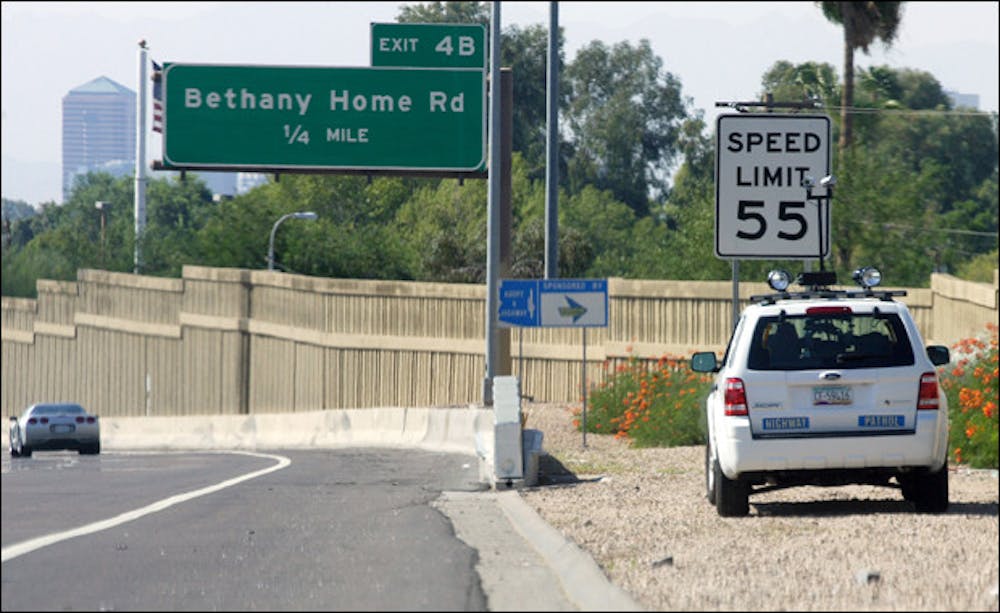The Arizona Department of Public Safety has launched a new initiative, using photo-radar cameras to increase speed enforcement across the state.
Friday, one of the three speed-enforcement vehicles deployed by DPS recorded more than 100 citations in the first two and a half hours, Lt. James Warriner said. The vehicle was located on Arizona 51 between Cactus and Thunderbird roads.
The new program, approved by lawmakers and signed into law by Gov. Janet Napolitano on June 27, will place 100 new stationary and mobile speed cameras throughout Arizona.
Napolitano cited public-safety benefits demonstrated by cameras deployed in Scottsdale when she directed DPS to develop a new photo speed-enforcement program in 2007, according to The Associated Press.
She also projected new revenue from citations will be around $90 million.
Three photo-enforcement vehicles kicked off the program, and the DPS plans to add four more throughout this week.
Over the next month, five vehicles will be added each week until 40 are operating by the end of November.
The locations won’t be publicized, Warriner said, but photo-enforcement signs will be put up near vehicles.
“We don’t feel the need to advertise,” Warriner said. “We want people to comply with the law; they don’t need to be warned.”
DPS also changed the trigger speed of the cameras to 10 mph over the posted speed limit on Friday, down from 11 mph in the past.
“Ten miles per hour over the speed limit is very dangerous,” Warriner said. “The speed limits are posted so frequently on freeway systems that people should know.”
The first of the 60 immobile photo-radar cameras will be operating by late October, Warriner said. All of the stationary units will be active by the end of January.
Though no locations have been decided at this time, Warriner said there are three types of areas where cameras could be placed.
The first is areas with a rate of speed-related collisions.
The second is construction zones. When the regular mode of traffic is altered due to construction, speeders are more likely to be involved in accidents, Warriner said.
The third is junction areas, where more than one freeway or highway comes together, he said.
“When the flow of traffic changes, like when highways meet, motorists are more likely to be involved in accidents,” Warriner said.
The department has found that both photo-enforcement vehicles and stationary cameras are very effective, he said.
All data have shown comparable results between the two methods of capturing speeders.
Arizona is the first state to implement a statewide photo-radar system, he said. The cameras are contracted through Redflex Traffic Systems Inc.
Similar programs have been successful in Australia and Great Britain, according to the DPS Web site. The number of motorists exceeding the speed limit in monitored roadways is down 66 percent in Victoria, Australia, and 32 percent in Great Britain.
Warriner said he has high hopes for Arizona’s program.
“It should decrease the number of speeders across the state significantly,” he said. “Arizona is becoming an example for other states across the country.”
In addition to the statewide program, many Arizona cities have placed speed cameras on their streets.
A speed-enforcement camera on Rural Road operated by the city of Tempe flashed sophomore marketing student Grant Garber last semester.
Garber said while he thinks it is fair to expect motorists to know the posted speed limit, it isn’t fair when there are irregularities.
“I thought the camera was broken because I kept seeing it [flash],” he said.
Garber realized he was flashed because the speed limit changes from 40 mph to 35 mph.
At night, warning signs are difficult to see and only on the right side of the road, he said.
“I saw other people get flashed too,” he said. “I don’t think people know.”
Reach the reporter at tessa.muggeridge@asu.edu.




